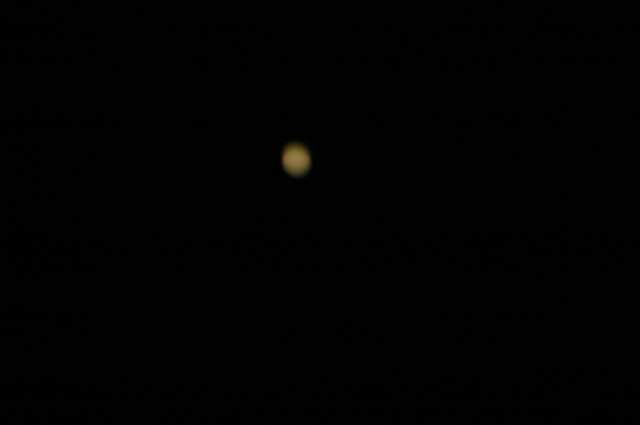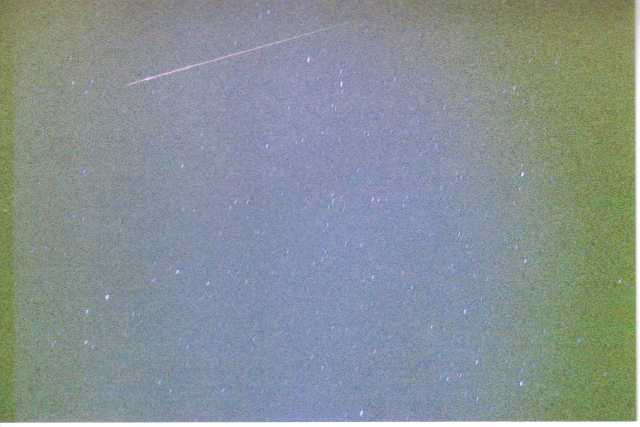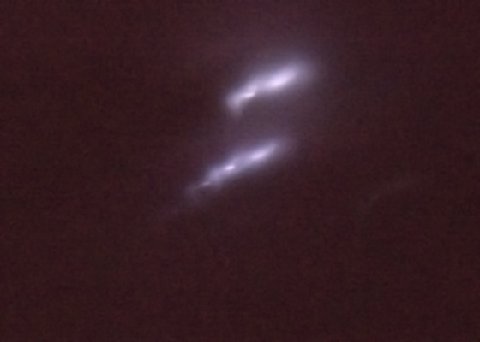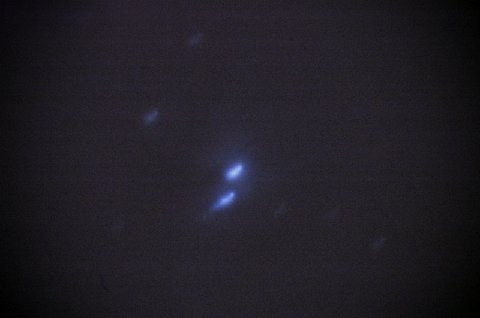Last updated: 26 September 2007
|
Last updated: 26 September 2007 |
This page documents Nikon D70 and other Nikon DSLR camera comments, tips, and photos. Search the site for "nikon dslr" for other items about the Nikon DSLR cameras. Contributions welcome.
Subject: Big Moon Problems Sent: Wednesday, September 26, 2007 13:53:58 From: Jim and Char (jgemmel@verizon.net) I own an ETX-125EC and am trying my hand at astrophotography using my Nikon D80. In the attached prime-focus picture of the Moon (taken 09/22/07), I attached the D80 to the camera port via a T-adapter and T-mount. The picture looks good except for a little blur from vibration, but I would like to know what can be done to capture the entire moon in the shot ? Is there a field reducer I can attached to the t-adapter or anything ?Mike here: There are some focal reducers discussed on the Accessory Reviews: Astrophotography page. To eliminate vibration from shutter/mirror movement try using the "hat trick" method. For bright objects like the Moon, set a low ISO setting. Alternatively, set a high setting and use a the fastest shutter speed you can and still get the image. Using a Remote Control or self-timer will also help.Regards; Jim Gemmel Warrenton, VA "Virgin" Backyard Astronomer P.S. - Love your ETX site. Use it all the time for reference. I'd be lost woithout it.
Subject: camera adapter Sent: Saturday, September 1, 2007 14:07:42 From: hameed haji (hameedhaji88@yahoo.com) recently i bought an adapter form meade to be fixed on one side of ETX125 and anther side to fixed to a camera ( nikon D 80 digital ) but still i cannot use or fix the camera please advise best regards hameed hajiMike here: Read "My Nikon D70 DSLR" articles on the Helpful Information: Astrophotography page. You likely need a T-Ring Adapter.
Subject: Re: maxview dslr 2 Sent: Friday, August 31, 2007 21:01:35 From: Charles Eye (nitesky3@att.net) Hi there Mike, thanks for the reply back, I just completed an outing of an attempt to capture Jupiter, appreciate the note on the stiletto-focuser. I set up the scope and here is what I got, after changing shutter speeds about 6 times the first picture looks fairly focused but very dim. the next one, and each one after that, well you can see the rusults if the pics come through to you... its a lot of work setting up and tearing down to get such dissapointing photo's but what the heck, its fun trying lol... thanks again... Chuck


And:
Hello again, yes as a matter of fact I have tried the hat trick but not with the D 70. Several yrs. ago I got an early start driving down to visit my dad when I noticed the full moon was getting close to the western horizon. I decided to pull over and put the telephoto lens on my regular film slr camera. With it on the B setting I used the cable release to open the shutter and if I remember correctly every 2 and 1/2 min. I took the cap off and put it back on.. that one was kinda fun when people would see 4 moons in the sky, I told my sister that this time of year when the atmospheric conditions were right it caused a mirror effect, she believed that untill a couple weeks I let her know I made it up loll..... The D70 though, I am still not sure about how to do that sense it doesn't seem to have a B setting like a film slr camera does... A camera store here offers a class for digital photography, I plan on signing up for their next class to maybe get a better understanding of the D70... as you can see the timing was good between the first to moons and then I lost the exact time to take the cap off and on.... take care...... Chuck

And:
Ah!!!!, I'll be darned, when I read this I had to go grab the camera and
put the main dial back on the S for shutter speed priority if I
understand that correctly. I was able to take it all the way down to
where the shutter stayed open for 30 seconds, this must be that bulb
setting?? I noticed you used the word { up } I also tried taking it up
to as far as it would go and that seems to be 4000'th of a second I
think it is.... I was looking for a letter B, or the word bulb. Is the
30 seconds equivalent to the bulb? for planets I would think that would
be more than enough time to touch the remote to open the shutter and
wait 15 seconds or so to move away the black card or [hat] and put it
back.... Mike, I really appreciate your taking the time to help me on
this, your a life saver its going to be clear again tonight so can't
wait to try it once again... clear skies to you...... Chuck,,,, another
thing I love doing is going out for the meteor showers,, but the light
pollution here, even when I drive out to where I can see the milky way
going across the sky I still get this kind of pic... I could get an
earlier start and drive farther of coarse......

And:
Good morning, I do have one of those ML-L3 romote control's, I got the camera and put in on the m for manual and sure enough there it was, on my D 70 I was surprised to see the word bulb, I pushed the button and held it for about 45 seconds to insure it would stay open more than the 30 seconds the sales person told me when I bought it, he said that was the limit as far as time exposures... I did notice that when the button is released it seems to take just as long for picture to develop as the time the shutter was open... I set out to give it another try last night but couldn't find my screws to attach the bar for the counter weight. I found them this morning in the pocket of the jeans I was wearing the night before, guess I've reached that age where the mind is slipping lol.lol.... anyway thanks again Mike, I need to drive down to Eldoredo Mo. today so will be a while before I can give it another try,, I'll let you know how it turns out.... Have a good rest of the weekend and Holiday.......... ChuckMike here: I have left the shutter open for over 10 minutes. If you have turned Noise Reduction ON then it takes twice as long as the exposure to process the image. A five minute exposure will require five more minutes when the shutter is closed.
Subject: maxview dslr 2 Sent: Friday, August 31, 2007 15:42:34 From: Charles Eye (nitesky3@att.net) Hi, was just looking at your pictures, I seem to have the same set up as yours accept my scope is the Celestron 11" ...... I hooked my Nikon D 70 to the dslr 2 using the 35mm Panoptic lens, but not knowing your camera really makes a difference. I tried taking a pic of the Moon and it looked kinda dark for being almost full, I went from 400 speed film or epuivelent to 800, then 1600 and later learned that I was actually changing the shutter speed lol lol... duh !! if the wind should die down a little more am going to try again tonight I am attaching one of these dark moon pics for you to see what I mean... I enjoyed reading your site and thanks for sharing your pics and info. I found it very very helpful.. have a good a clear day and evening. Chuck......

Subject: Nikon D200 Piggy Backed ETX105 Sent: Thursday, August 23, 2007 13:38:03 From: PETER SMITH (psmithuk@btinternet.com) The following URL is to my webspace (not web page I dont share your webmasters skills and just use it to make data available to others) and has a few images from my first attempts at Piggy Backing my D200 onto the ETX105. www.btinternet.com/~psmithuk/AstroPhotos/ Due to the size of the images I haven't attached them. The images are unprocessed 10MP Jpegs I have the raws to work on but they make very large files. I hav e also been experimenting with producing overlays using autostar suite which I can then drop over the top of my photos once i perfect the technique i'll let you and the rest of the world know how to do it..Briefly it's a multistage process ... Screen grab the image from AutoStar Suite with the stars and objects turned off... make background transparent (save as GIF)...Scale and align with photo and merge the images. The D200 had a Sigma 50mm Macro Lens fitted (effective focal length 75mm due to sensor size on the D200) Exposures Were 1 min at ISO 800 F2.8. I have made an adpater which allows the D200 to be mounted in the Eyepiece port of the ETX105...My etx now has the standard finder an Astro Engineering Reddot and A 240mW 532nm LAser Pointer all co-aligned with the main tube. The Poiner makes casual searching of the sky a breeze and causes quite a stir with the "locals" The wind was blowing about 20 MPH so not ideal and the shots at 300mm (effective 450mm) exhibited a lot of "camera" shake. Looking for a new dark skies site which looks like a 50 mile trip.... Regards, Peter Smith
And:
I have added an untracked image of Orion which is a 60s exposure at equivalent of 38mm FL and it shows evidence of trailing...Got up a little bit too late to get it at its best so didn't have time to do a polar alignment and take tracked images maybe tomorrow night/morning... When I went to bed at about 11 pm it was still quite cloudy but a peak out of the window at 4 am it was really quite clear so got the gear in the car and drove a few miles to a local mountain top - not very dark skies but good 360 degree views. No time to let the gear cool down so decided to just take some experimental shots... I have got a DSI Color on its way from the US - the "End of Line" sale prices haven't made it to the UK and want to experiment with autoguiding the ETX using it Whilst taking Wide field shots using the D200 - This will require the fabrication of yet another SLR mount unless I use the DSI on the Rear Cell while mounting the DSLR in the eyepiece tube... Ah well got a month off between jobs so time to design and manufacture some more addons :) If your just linking to the images I will upload some processed RAWs . I am starting to experiment with DeepSKyStacker (http://deepskystacker.free.fr) as it supports RAW format images and has Dark and Flat processing and Stacking . I have also got the Nikon MC-36 timer remote which makes taking sequences for stacking really easy...Just program it up and let it go. I produced a complete set of darks for My D200 over the ISO range 100-1600ASA and exposures from 15-300s at 20C and will have to repeat this at lower temps as we head into winter. Best Regards, Peter Smith
Subject: Hello Sent: Sunday, April 8, 2007 08:56:12 From: Dan (dholler01@alltel.net) I just wanted to thank you for the data and pictures which you have put onto your web site. I work with astronomical ccd cameras, and currently, have been working with a camera designed around the ccd module of the D50. Of course, the same ccd assembly was also used in the D70 series. Because of this fact, I have torn a few D50s apart, and been told the D70 is similar. In doing so, I had an interest in designing a camera using the existing D50 circuitry. Your photographs and detailed discussion have confirmed one of my suspicions on using DSLR cameras in astronomy. That being, without adequate cooling the cameras are somewhat limited in astronomy. If I do develop such a project, I will keep the websites you mention in mind. The other shortcoming is proper software. Just in case you, or others, are interested in seeing more of what your camera's ccd is capable of producing in an astronomy application, you may want to visit this site: http://qhyccd.com/ccdbbs/index.php?board=1.0 Thank you again, Dan
Subject: Astronphotography Sent: Tuesday, March 27, 2007 23:48:37 From: Roy van der Westhuizen (roy@ion.co.za) Thanks for the advice and fast response, Mike. As far as deciding on what type of Astrophotography, I am still very much at the discovery stage. Will be attending the ScopeX exhibition in Johannesburg on 21 April as well as a lecture my Richard Berry the night before. As far as time and effort are concerned, there will be a fair amount of that available. I will spend time looking at your site and others. Find this a fascinating direction to go in. Regards, Roy
Subject: Comet McNaught Sent: Tuesday, March 27, 2007 03:49:28 From: Roy van der Westhuizen (roy@ion.co.za) Just come across your site as I am considering buying a Meade ATX ??? to shoot from our nice clear skies. I have just bought a little 200 acre farm near Paul Roux in The Eastern Free State, South Africa which will be perfect for astrophotography. This was among my first attempts taken with a Nikon D100 using a 70-300 zoom. It was taken 8:00 p.m. RAW and then converted in CS2. White Mountains near Fouriesburg, Eastern Free State.Mike here: First off you need to decide just what type of astrophotography you want to do and how much time and effort you plan to devote to it. All of the ETX models can do some types of astrophotography as you can see on my ETX Site. But the lower end models will have greater challenges than the larger models. Also, the type of imager you plan to use can be a factor (DSLR or dedicated imager, for example). I suggest you look over the galleries as well as the Helpful Information: Astrophotography to help you formulate your needs. You may find that you need/want a larger telescope, such as an LXD75 model, a LX90 model, or perhaps even a higher end model.What Meade model would be recommended? Budget and level of experience, low, are a factor, but I don't want to buy something, like my D100, and then find I should have looked around a bit more Regards, Roy
Subject: Re: Orion Nebula thru ETX125PE Sent: Saturday, February 10, 2007 07:44:40 From: User721401@aol.com (User721401@aol.com) The camera was mounted thru the photo tube on the back of the scope. I was unable to see the image thru the camera using the Max view dslr. My LPI was ready to go, then the laptop decided to quit (motherboard is done). Image trailing is from movement? Thank for any and all advice!! DanMike here: Yes, the image trailing is due to tracking errors. The AutoStar doesn't track that accurately for unguided exposures. You can make it better by putting the telescope in the Polar mode, which also avoids "field rotation" when in Alt/Az. Alternatively you can attach a "guidescope", which is just a high magnification telescope through which you monitor a bright star and keep it centered. The simplest way to do astrophotography with the ETX and a D70 is piggyback. For more on using the D70 for astrophotography see "My Nikon D70" on the Helpful Information: Astrophotography page; lots of info there.
And:
Thanks for the tips... I am still learning all this.... Dan
Subject: Orion Nebula thru ETX125PE Sent: Friday, February 9, 2007 16:18:42 From: User721401@aol.com (User721401@aol.com) Here are some pics of the Orion Nebula taken last night with Etx125PE and Nikon D70.. This is my first attempt at it. The original was shot in a NEF (Nikon's Raw format) and edited in Photoshop CS2. Not much editing was done do to lack of experience. I also tried to edit it in MaximDL, but lack of knowledge is holding me back. This one of about 10 shots taken at various exposures. This one lasting about 4.5 seconds. Enjoy... Dan Chicago, IL


Return to the top of this page.
Go to the 2006 Nikon D70 Discussion page.
Go to the 2005 Nikon D70 Discussion page.
Go to my Nikon D70 Astrophotography page.
Go back to the Astrophotography Page.
Go back to my ETX Home Page.